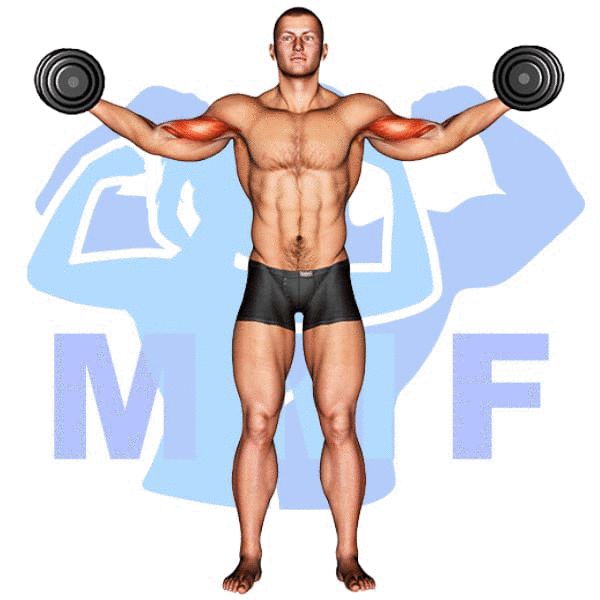Do you ever feel like you’re not seeing the results you want from your chest workouts? Maybe you’re doing all the classic exercises: bench press, push-ups, chest flys, but it’s just not giving you the definition and strength you’re looking for. Don’t worry, you’re not alone. Many people struggle to see progress in their chest muscles even with consistent effort. But the good news is, there’s a solution – cable crossover flys. In this blog post, I’ll walk you through how to properly execute cable crossover flys to achieve the results you’ve been looking for.
Cable Crossover Flys Summary
- Primary Muscles: Pectoralis Major – Sternal
- Secondary Muscles: Latissimus Dorsi, Levator Scapulae, Pectoralis Major – Clavicular, Pectoralis Minor, and Rhomboids
- Equipment: Cable Machine with Two Single D-Handles
- Mechanics Type: Isolated
- Force: Push
- Utility: Auxiliary
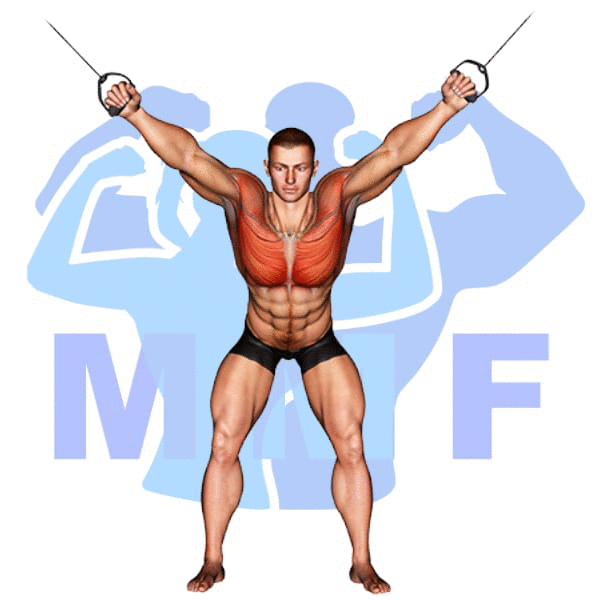
Cable Crossover Flys Instructions
- Attach two handles to opposing high pulleys.
- Grab a handle in each hand while you stand in the middle of both pulleys.
- Slightly bend at your hips and bend your elbows while internally rotating your shoulders so your elbows are back.
- Now, pull the handles together in front of your abdomen, keeping your elbows in the fixed position.
- Return to starting position allowing your chest to stretch slightly.
- Repeat for a full set.
Video Tutorial
Cable Crossover Flys Muscles
Target (Agonist)
- Pectoralis Major – Sternal
Synergists
- Latissimus Dorsi
- Levator Scapulae
- Pectoralis Major – Clavicular
- Pectoralis Minor
- Rhomboids
Dynamic Stabilizers
- None
Stabilizers
Antagonist Stabilizers

Benefits of Cable Crossover Flys
Cable Crossover Flys are an effective exercise for strengthening the pectoralis major – sternal muscle. This muscle is responsible for adducting and flexing the arm, allowing the arms to move across the body and the torso to rotate. By performing Cable Crossover Flys, you are able to target this muscle specifically, increasing its strength and stability. This exercise also works to improve shoulder flexibility and stability, while helping to reduce the risk of shoulder injury. Additionally, Cable Crossover Flys can help to improve posture and even improve cardiovascular health.
Tips for Performing Cable Crossover Flys
You’ve come to the right place if you’re motivated to advance your cable crossover flys execution. Using these suggestions can allow you to maximize the advantages of this amazing workout. You’ll be able to strengthen your chest muscles, and minimize your chance of getting hurt. So let’s start now and see what these tips may accomplish for you.
- Use Proper Form: Make sure to keep your back straight and your core engaged throughout the exercise. This will ensure you are getting the most out of each rep and not risking injury.
- Keep Your Hands Close: Keep your hands close together as you bring them across your body. This will target the chest muscles more effectively.
- Control the Weight: Don’t use too much weight. Focus on controlling the weight as you move it across your body, rather than trying to lift as much as possible. This will help you achieve a better workout and prevent injury.
Benefits and Tips Video
Frequent Mistakes To Avoid
When it comes to executing cable crossover flys, avoiding typical errors is usually the difference between an effective workout and a painful injury. From bad form to not engaging your core, these errors can diminish the productiveness of the exercise and can even increase your risk for injury. However, take it easy, it’s not as challenging as it might seem. By knowing the errors to avoid and taking the appropriate actions, you may complete the activity safely and effectively. Let’s start by avoiding these typical errors and incorporating this exercise to your training regimen.
- Not using proper form: It is important to use proper form when performing the exercise Cable Crossover Flys, as incorrect form can lead to injuries and impede progress.
- Not using the appropriate weight: Using a weight that is too light or too heavy can reduce the effectiveness of the exercise and increase the risk of injury.
- Not taking adequate rest periods: Taking too long of a break between sets of Cable Crossover Flys can lead to fatigue, reduce motivation, and hinder progress.
Find More Cable Exercises Here
Variations and Complementary Exercises
There are a variety of exercises that can be used to target the same muscle groups as Cable Crossover Flys. Below is a list of exercises that can be used as variations, complementary, or alternative exercises to help you get the most out of your workout.
Cable Decline Fly
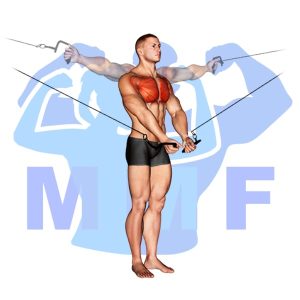
The Cable Decline Fly is a great exercise to pair with Cable Crossover Flys as it helps to further develop the chest muscles while avoiding overtraining. This exercise works the lower chest muscles and involves lying on a decline bench while holding onto a high pulley cable in each hand. The arms are then opened in an arc-like motion, creating tension on the chest muscles. The cable decline fly is a great complement to cable crossover flys, helping to build a balanced, strong chest.
Cable Flys

Cable Flys are a great complementary or alternative exercise to Cable Crossover Flys. This exercise works the same muscle groups as the Cable Crossover Flys, but with a slightly different motion. With Cable Flys, you stand in the middle of a cable crossover machine and grasp the handles with your arms extended out to your sides. Then, you pull the handles together in front of you, squeezing your chest muscles as you do so. Cable Flys are a great way to add variety to your workouts and help you target your chest muscles from a different angle.
Cable Low Fly

Cable Low Flys provide an effective alternative or complementary exercise to Cable Crossover Flys. This exercise targets the same primary muscle groups as Cable Crossover Flys, but with a different range of motion. With Cable Low Flys, the arms are extended outwards to the sides instead of upwards, allowing for a greater stretch in the chest muscles. Additionally, the arms remain parallel to the floor, providing a constant tension on the chest muscles throughout the entire range of motion. As a result, Cable Low Flys can help build a stronger and more balanced chest than Cable Crossover Flys alone.
Check Out These Top Cable Exercises
Decline Dumbbell Fly
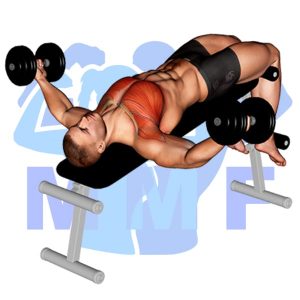
Decline dumbbell flys are a great complement or alternative to cable crossover flys. It is an isolation exercise that targets the chest muscles, specifically the lower and inner chest. This exercise can be done by lying on an inclined bench while holding a dumbbell in each hand with palms facing each other. From this starting position, you will raise your arms up and out to the side until your hands are parallel to the floor. You will then slowly lower the dumbbells back to the starting position, feeling a stretch in your chest muscles as you do so. Decline dumbbell flys provide an intense workout for your chest, and can be used to target areas that cable crossover flys may not be able to reach.
Decline Dumbbell Twist Fly

Decline Dumbbell Twist Fly is an excellent complement or alternative to Cable Crossover Flys. This exercise is performed on a decline bench and involves holding a pair of dumbbells with the palms facing each other. The arms are then extended out to the sides and slowly brought up in an arc, twisting at the wrists as the arms come together at the top of the movement. This exercise provides an intense challenge to the chest muscles, activating both the pectoralis major and minor muscles. Decline Dumbbell Twist Flys can be used as a substitute for Cable Crossover Flys or as an additional exercise to further challenge the chest muscles.
Dumbbell Fly

Dumbbell Flys are an excellent alternative or complementary exercise to Cable Crossover Flys. This exercise targets the same muscles as the cable crossover flys, but with a different form and range of motion. In this exercise, the user will lie on their back with two dumbbells in their hands, palms facing inwards. They will then raise the dumbbells out to the side in an arc-like motion, stopping when the dumbbells are parallel to the floor. This exercise will help to increase strength and definition in the chest and shoulder muscles, while also engaging the core and upper arms.
Find More Chest Exercises Here
Opposing Complementary Exercises
In addition to Cable Crossover Flys, it is important to include exercises that target the opposing muscle groups. These exercises will help promote balance in the upper body and will ensure that the body is being worked evenly. By incorporating these exercises into your routine, you will be able to see greater benefits from your workouts. Below are a few exercises that work the opposite muscles as Cable Crossover Flys.
Lever One Arm Lateral High Row (Machine)

The Lever One Arm Lateral High Row machine is an excellent complement to the Cable Crossover Flys exercise. This machine works the opposing muscle group to the pectorals, targeting the back muscles, including the latissimus dorsi, teres major and minor, and rhomboids. By performing both exercises in a workout, it is possible to achieve a balanced strength program. The Lever One Arm Lateral High Row machine allows for unilateral training with adjustable arm lengths that allow for a full range of motion to effectively target the upper back muscles. As an added bonus, this exercise also helps to improve posture and reduce risk of injury.
Smith Machine Bent Over Row
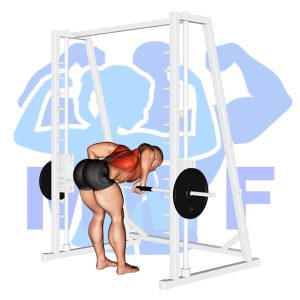
The Smith Machine Bent Over Row is a great complementary exercise to Cable Crossover Flys because it targets the opposing muscle group, the back. This exercise requires the user to hold a barbell with an overhand grip and bend over at the hips, keeping the back flat. The barbell is then pulled towards the chest while squeezing the shoulder blades together. The bent over row strengthens the back muscles, helping to create balance and stability in the body which helps to increase overall strength.
Underhand Dumbbell Row
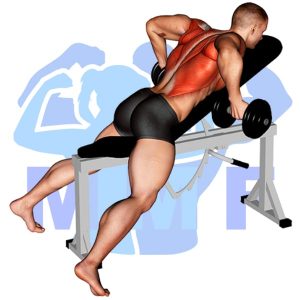
Underhand Dumbbell Row is a great complement to the Cable Crossover Flys exercise. This exercise targets the back muscles, specifically the lats, by having the user grip a pair of dumbbells with an underhand grip and pull the weights up towards their chest while keeping their back straight. This motion works the opposing muscle group from the Cable Crossover Flys, which works the chest muscles, and helps to create balance in your upper body. The Underhand Dumbbell Row is an effective way to strengthen your back and make sure your upper body is properly balanced.
Fly Your Way to a Stronger Chest
Fly your way to a stronger chest with cable crossover flys! This exercise is great for targeting the pecs and will help you build muscle mass and definition. By adjusting the height of the cables, you can target different parts of the chest and get a full range of motion. Don’t forget to engage your core and keep your back straight throughout the exercise to avoid injury. Incorporating cable crossover flys into your workout routine can help you achieve your chest goals and improve upper body strength.
References: Wikipedia | ExRx.net | PubMed.gov | Comprehensive List of Chest Cable Exercises

